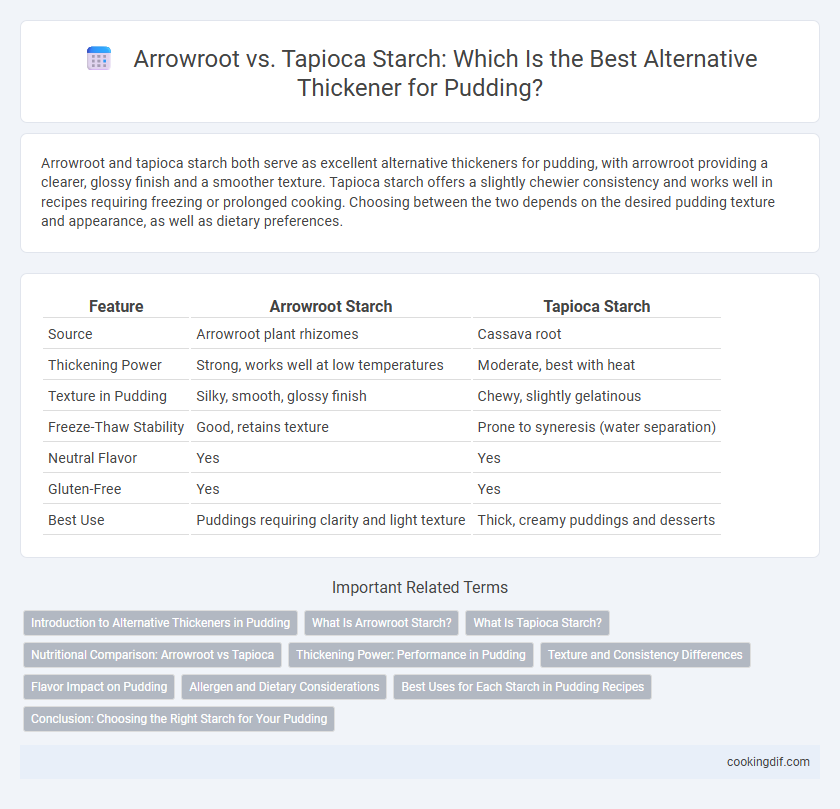Arrowroot and tapioca starch both serve as excellent alternative thickeners for pudding, with arrowroot providing a clearer, glossy finish and a smoother texture. Tapioca starch offers a slightly chewier consistency and works well in recipes requiring freezing or prolonged cooking. Choosing between the two depends on the desired pudding texture and appearance, as well as dietary preferences.
Table of Comparison
| Feature | Arrowroot Starch | Tapioca Starch |
|---|---|---|
| Source | Arrowroot plant rhizomes | Cassava root |
| Thickening Power | Strong, works well at low temperatures | Moderate, best with heat |
| Texture in Pudding | Silky, smooth, glossy finish | Chewy, slightly gelatinous |
| Freeze-Thaw Stability | Good, retains texture | Prone to syneresis (water separation) |
| Neutral Flavor | Yes | Yes |
| Gluten-Free | Yes | Yes |
| Best Use | Puddings requiring clarity and light texture | Thick, creamy puddings and desserts |
Introduction to Alternative Thickeners in Pudding
Arrowroot and tapioca starch serve as popular alternative thickeners in pudding due to their ability to create smooth, glossy textures without altering flavor. Arrowroot starch, derived from the roots of tropical plants, offers a neutral taste and sets at lower temperatures, making it ideal for delicate puddings. Tapioca starch, extracted from cassava root, provides a slightly chewier texture and better freeze-thaw stability, enhancing pudding consistency in refrigerated desserts.
What Is Arrowroot Starch?
Arrowroot starch is a fine, white powder extracted from the rhizomes of tropical arrowroot plants, commonly used as a natural thickening agent in cooking and baking. It forms a clear, glossy gel when heated with liquid, making it ideal for puddings and sauces that require a smooth texture without cloudiness. Unlike tapioca starch, arrowroot avoids a gummy consistency and remains stable at low temperatures, enhancing the clarity and mouthfeel of desserts.
What Is Tapioca Starch?
Tapioca starch, derived from the cassava root, is a gluten-free, neutral-flavored thickener commonly used in puddings and desserts for its smooth, glossy texture. Its fine, powdery consistency allows it to create a clear, stable gel that enhances mouthfeel without altering flavor profiles. Unlike arrowroot, tapioca starch is more resistant to freezing and thawing, making it ideal for puddings requiring storage or reheating.
Nutritional Comparison: Arrowroot vs Tapioca
Arrowroot starch contains higher amounts of potassium and iron compared to tapioca starch, making it a more nutrient-dense thickening option. Tapioca starch primarily provides carbohydrates with minimal vitamins and minerals, offering little nutritional benefit beyond energy content. Both starches are gluten-free and suitable for pudding thickening, but arrowroot offers additional micronutrients that support overall health.
Thickening Power: Performance in Pudding
Arrowroot starch exhibits superior thickening power compared to tapioca starch, creating a glossy, smooth texture ideal for puddings. Tapioca starch, while effective, often produces a slightly more gelatinous consistency that can become rubbery when overcooked. For pudding recipes seeking a delicate, translucent finish with stable thickening under gentle heat, arrowroot starch is the preferred alternative.
Texture and Consistency Differences
Arrowroot starch produces a clear, glossy finish and creates a lighter, silkier texture in puddings, ideal for delicate desserts. Tapioca starch results in a thicker, chewier consistency with a slightly opaque appearance, providing a more substantial mouthfeel. Arrowroot sets quickly at lower temperatures, while tapioca holds up better under prolonged heating and freezing conditions.
Flavor Impact on Pudding
Arrowroot starch provides a clean, neutral flavor that preserves the delicate sweetness and creaminess of pudding, making it an ideal thickener for maintaining a pure taste profile. Tapioca starch contributes a slightly sweet and subtle earthy note, enhancing the overall flavor complexity without overpowering the pudding's base ingredients. The choice between arrowroot and tapioca starch directly influences the sensory experience, with arrowroot offering a lighter mouthfeel and tapioca delivering a richer, more textured finish.
Allergen and Dietary Considerations
Arrowroot starch is a hypoallergenic, gluten-free thickener suitable for sensitive diets, making it an ideal choice for those with wheat or gluten allergies. Tapioca starch, derived from cassava root, is also gluten-free but may cause digestive issues in some individuals due to its higher carbohydrate content. Both thickeners are grain-free options, but arrowroot is often preferred for its better digestibility and neutral flavor in allergen-conscious cooking.
Best Uses for Each Starch in Pudding Recipes
Arrowroot starch creates a clear, glossy pudding with a smooth texture, making it ideal for fruit-based and delicate flavored puddings. Tapioca starch offers a chewier consistency and opaque finish, perfect for creamy, rich puddings like coconut or chocolate varieties. Using arrowroot preserves the pudding's clarity and intensifies fresh flavors, while tapioca provides a comforting, hearty mouthfeel suitable for warm, dense desserts.
Conclusion: Choosing the Right Starch for Your Pudding
Arrowroot starch creates a clearer, glossier pudding with a smooth texture and works best at lower temperatures, making it ideal for delicate flavors. Tapioca starch produces a thicker, chewier consistency and holds up well under prolonged cooking or freezing, perfect for rich, hearty puddings. Selecting between arrowroot and tapioca starch depends on the desired texture, clarity, and cooking method for your pudding recipe.
Arrowroot vs tapioca starch for alternative thickener Infographic

 cookingdif.com
cookingdif.com